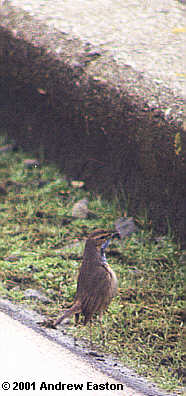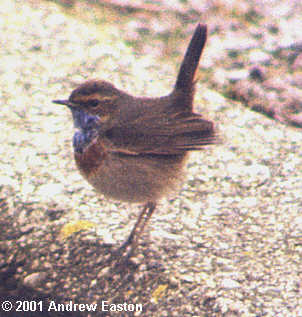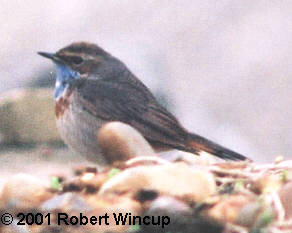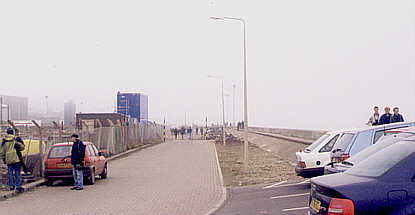|
|
WHITE-SPOTTED
BLUETHROAT
Luscinia svecica cyanecula
Ness Point
2001

THE WEATHER FORECAST FOR Saturday March 24, 2001 looked very promising, with a combination of east to south-east winds and coastal fog. After failing in our efforts the weekend before to find any Northern Wheatears, Oenanthe oenanthe, it now seemed fairly certain we would find one on the 24th.
 We
agreed that we rendezvous at Ness Point about 12:30 to discuss what we had
found at various sites in town before deciding what to do next. The day started
very well, being quite sunny in spite of the fog. Between us we located four
Northern Wheatears between the North Denes Camp Site and Lowestoft Harbour,
and James Brown found two more at Corton, as well as two Firecrests, Regulus
ignicapillus, and a Brambling, Fringilla montifringilla, at Hopton.
As the morning wore on the cloud cover increased becoming very dull and the
fog did not lift all day.
We
agreed that we rendezvous at Ness Point about 12:30 to discuss what we had
found at various sites in town before deciding what to do next. The day started
very well, being quite sunny in spite of the fog. Between us we located four
Northern Wheatears between the North Denes Camp Site and Lowestoft Harbour,
and James Brown found two more at Corton, as well as two Firecrests, Regulus
ignicapillus, and a Brambling, Fringilla montifringilla, at Hopton.
As the morning wore on the cloud cover increased becoming very dull and the
fog did not lift all day.
As we headed from the North Denes Camp Site towards Ness Point, Rob Wilton jokingly told Chris Mutimer, who was then heading home, that we would give him a ring when we found the Bluethroat. Rob then decided to walk south along the seawall, whilst Robert Wincup, Robert Holmes and myself drove there.
When we reached the car park at Ness Point having quickly checked the gulls at the outfall we looked north to see where Rob had got to. We could see him setting up his scope to look at something in the Birds Eye car park, (three more Northern Wheatears) and as we looked to see if we could see what he was looking at I noticed a small passerine fly up from the drainage ditch a few metres ahead of us, it then flew low along the roadway before turning and flying up onto the seawall. It appeared to be one of the local Black Redstarts, Phoenicurus ochruros, but when it landed and cocked its tail almost vertically alarm bells started to ring. Looking closely I could make out the dark breast contrasting with the pale belly, although in the poor light with binoculars the colour of the breast was not apparent. I contend that I then said "It's a Bluethroat!", the two Roberts on the other hand say swear words were involved, though I'm sure they must be mistaken. Honest!!
 Whilst
looking at the bird we could see Rob Wilton standing just a few metres beyond
the Bluethroat still looking through his telescope blissfully unaware of the
birds presence. We all shouted and pointed in a downwards direction. Initially
he thought we were pointing out a Northern Wheatear to him which he had already
spotted in the same ditch, then noticing the bird on the wall in front of
him, now in a more relaxed pose, raised his thumb to thank us for pointing
out what he, at first, also took to be a Black Redstart. We were then treated
to one of the best double takes we have ever seen as he raised his binoculars
to view it, then hastily turned to grab his scope when he saw what it really
was.
Whilst
looking at the bird we could see Rob Wilton standing just a few metres beyond
the Bluethroat still looking through his telescope blissfully unaware of the
birds presence. We all shouted and pointed in a downwards direction. Initially
he thought we were pointing out a Northern Wheatear to him which he had already
spotted in the same ditch, then noticing the bird on the wall in front of
him, now in a more relaxed pose, raised his thumb to thank us for pointing
out what he, at first, also took to be a Black Redstart. We were then treated
to one of the best double takes we have ever seen as he raised his binoculars
to view it, then hastily turned to grab his scope when he saw what it really
was.
We then retrieved our telescopes from the cars and were treated to excellent views of a male White-spotted Bluethroat as it fed in the open with a Northern Wheatear in a rubble and rubbish strewn drainage ditch. Most of the Lounge Lizards arrived very shortly after we had phoned the news out, including Chris Mutimer, and the bird attracted quite a crowd during the afternoon, treating most to excellent views in the same ditch, though it did skulk in some Tamarisk, Tamarix gallica, bushes, at one point. Despite the poor light several photos and some video footage was obtained. You can view a couple of the videograbs and another photo by clicking here.
 Encouraged by this find,
and the large number of Northern Wheatears present, we decided to check for
migrants to the south of the town in the Kensington Gardens and Pakefield
Beach and Cliffs area. We were very surprised to find that there were no migrants
at all in this area. As a result we returned to Ness Point and watched the
Bluethroat for a little longer.
Encouraged by this find,
and the large number of Northern Wheatears present, we decided to check for
migrants to the south of the town in the Kensington Gardens and Pakefield
Beach and Cliffs area. We were very surprised to find that there were no migrants
at all in this area. As a result we returned to Ness Point and watched the
Bluethroat for a little longer.
It was reported again at dawn the next day in the Birds Eye car park but could not be located later, but the weather was much worse than the day before, and there are plenty of inaccessible and sheltered spots around the sewage and gas works where it could have hidden undetected.
 Because
of their generally shy and retiring nature Bluethroats have always been a
highly prized local rarity. During the 1990's only three were found in the
Lowestoft area. Despite the rather barren and unpromising surroundings the
last Bluethroat in Lowestoft was also at Ness Point. Found by Tommy Corcoran
on May 17, 1994, this bird was a male of the nominate red-spotted race, and
spent its time feeding around the gasometer and sewage pumping station. The
2001 individual is apparently the first of the white-spotted race to have
been recorded in the Lowestoft area.
Because
of their generally shy and retiring nature Bluethroats have always been a
highly prized local rarity. During the 1990's only three were found in the
Lowestoft area. Despite the rather barren and unpromising surroundings the
last Bluethroat in Lowestoft was also at Ness Point. Found by Tommy Corcoran
on May 17, 1994, this bird was a male of the nominate red-spotted race, and
spent its time feeding around the gasometer and sewage pumping station. The
2001 individual is apparently the first of the white-spotted race to have
been recorded in the Lowestoft area.
[HOME] [ABOUT US] [PHOTO PAGE] [RECENT NEWS] [SITE GUIDE] [ARTICLES] [LINKS]